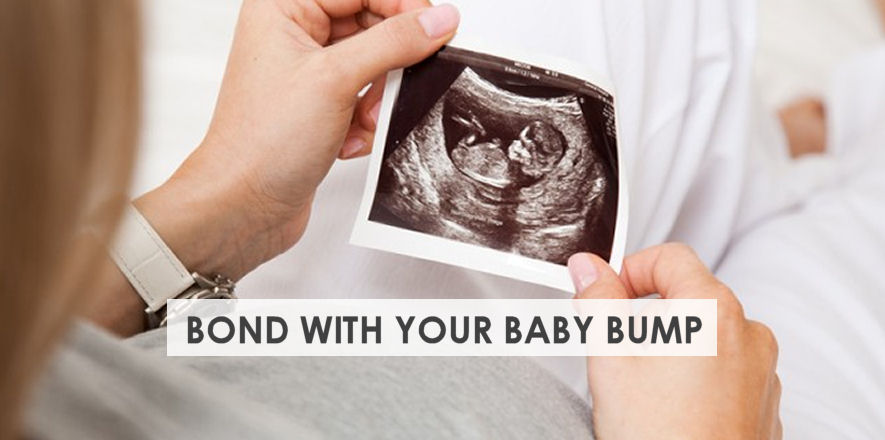The early weeks of pregnancy can seem surreal. You’re feeling rubbish, and you don’t have much to show yet. Once you have that first ultrasound scan, it starts to hit home. Your bump will soon grow, and you’ll begin to feel baby kicking.
This little bundle will soon be the focus of your life. When is better than now to start getting to know this new little person? Let’s look at some fun ways you can bond with your baby in the womb.
Pin for Later
Bond with Your Baby in the Womb
1. Choose a Nickname
Give your baby a nickname before you choose their official one. It’s a great way to give them personality before you meet them. You can choose a common nickname such as bump, bean or peanut.
You may find yourself making an inside joke with your partner about how baby looks in a scan photo. Another common theme is naming them after the size comparison item of your ‘pregnancy by week’ books or emails.
2. Belly Cast

A belly cast of your bump is a great keepsake of your pregnancy. The cast is made with plaster and gauze strips.
You can even decorate the cast and hang it in the nursery. You’ll probably want to leave this until the third trimester when your bump is fully grown.
If you have space make a series of casts throughout your pregnancy to show how your body has changed. This activity can help you come to term with accepting your changing pregnant body.
3. Dance
The rhythmic movement of dance can help you make your baby feel calm. Simple hip swaying is great way to rock baby in the womb.
Dancing releases happy hormones which can improve your mood and improve your babies development. You can even continue the movements whilst in labor as a distraction, keep you mobile and improve contractions.
4. Doppler
A home Doppler can be used for you to hear your baby’s heartbeat. The sound of baby’s heartbeat can make you feel closer to them.
You should never rely on a home Doppler for reassurance. The sounds you are hearing can be the placenta, cord or doubling of your own heart sounds. Trained professionals detect more than the heart rate.
If you have any concerns about your baby, consult with your caregiver for advice as soon as possible.
5. Flashlight Game
From around 16 weeks your baby will begin to react to light. The intensity is similar to what you see when you close your eyes in bright sunlight. Your baby will see shades of red and orange.
Some babies like the light and others try to turn away from it. Lay in a darkened room and shine a strong flashlight on your tummy to see if baby reacts.
Don’t be put off if baby doesn’t react in the early months you can try again as baby grows.
6. Movement Matters
From 24 weeks your baby will start to have a regular pattern of movements. Some babies are very active, others are a bit more laid back.
You will notice your baby move more during specific periods of the day. Tracking movement is exciting and help you feel connected to your baby.
The sensation of movement may change as baby grows. A reduction in number of movements is a sign baby may be distressed so contact your doctor or midwife if you have any concerns.
Read: Best Baby Products for First Time Moms
7. Music

Playing music to your baby in the womb can be very soothing to them. You don’t need to play classical music if it is not your usual style. Using speakers to play your regular tunes is a great way for baby to hear the rhythm.
You can now buy bump phones which can play music directly into your bump.
Just remember not to play it too loud or continuously. Research shows that ideally sound should be kept under 50 decibels for safety.
8. Nesting
In the third trimester, you may have a sudden urge to prepare for babies arrival. This usually includes cleaning the house, prepping the nursery or washing all of baby’s clothes.
Nesting is a natural instinct you’ll have to prepare you for baby’s arrival. You are providing a safe and caring environment for your precious baby. It will also help you prepare for the reality that you’ll soon have a baby to fit into those tiny clothes.
Nothing is safe from this instinct, so don’t be surprised if you suddenly have the urge to defrost the freezer.
9. Progression Photos

Another amazing keepsake for you and baby is to take weekly progression photos. Head over to Pinterest for some inspiration.
You can just show off your growing bump. Or add a little flair by including your partner, weekly updates props or pets.
Start with a positive test and finish with a photo of your baby when they are a few days old.
10. Read To Baby
Baby’s sense of hearing develops at around 12 weeks old. They are well tuned to the constant noises of your heart, lungs and other organs.
Your baby can hear muffled sounds and adjust to the tone of your voice and those in your family. Reading books directly to you bump gives you both time to relax.
Try to start reading a story you will read to baby when they arrive.
11. Talk to Bump
Both you and your partner should regularly talk to your bump. Once baby arrives they will already recognize the difference in sounds.
Hearing you talk can also be calming as it makes them feel as safe as they were in the womb. Singing to baby can make them more responsive to your voice during play time.
12. Scan Pictures
An ultrasound scan is the only way you can ever see your baby before they are born. If your caregiver allows, get some photos printed during the scan.
It’s fun for you and your partner to try and guess who baby looks like from the family. Do they have daddy’s nose or mom’s pouty lips?
3D scans can give you more in-depth detail of baby than a regular 2d scan.
13. Tummy Massage

Relaxation in pregnancy is often needed. Why not get some luxury massage oil (safe for maternity use) and give your bump a massage. You can do it yourself and have a good feel of baby’s lumps and bumps. Try and guess if it’s a hand, foot or tiny bottom you are feeling.
For family bonding your partner can give you a massage too. This also helps them to realize just how much work goes into growing a wriggly baby.
14. Visualization
A great way to bond with your baby is to imagine what they will be like as they grow. This may be easier if you know the sex of your baby.
Imagine playing football with your active boy of braiding your little girl’s hair.
Don’t try to make it too perfect or it can put pressure on you when baby arrives. Your baby may already be showing signs of their personality; they may be headstrong, laidback or stubborn!
15. Write a Letter
Take the time whilst you are on maternity leave to write a letter to your unborn baby. You can tell them about their personality or even the music like to move to.
A list of hopes and dreams for them is nice touch. As they grow you can let them read the letter as a keepsake memory.
Do you have any bonding tips you’d like to share with other pregnant moms? Then leave us a comment below, we’d love to hear from you.






